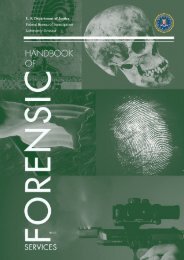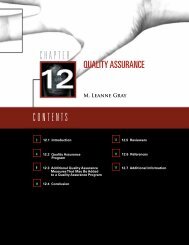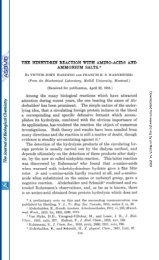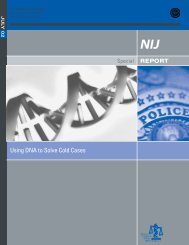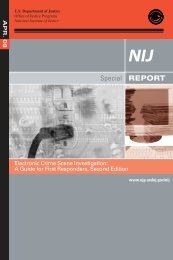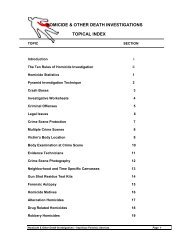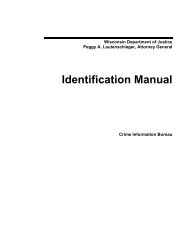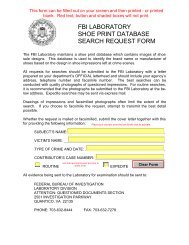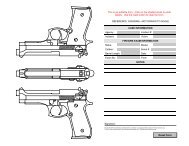Chapter 4 - Imprimus Forensic Services
Chapter 4 - Imprimus Forensic Services
Chapter 4 - Imprimus Forensic Services
You also want an ePaper? Increase the reach of your titles
YUMPU automatically turns print PDFs into web optimized ePapers that Google loves.
<strong>Chapter</strong><br />
Recording living and<br />
postmortem friction<br />
ridge exemplars<br />
Brent T. Cutro, Sr.<br />
CONTENTS<br />
3<br />
4.1 Introduction<br />
17<br />
4.5 Summary<br />
3<br />
4.2 Equipment 18 4.6 Reviewers<br />
5<br />
4.3 Recording Fingerprints, Palmprints, .<br />
and Footprints of Living Subjects<br />
18<br />
4.7 References<br />
10<br />
4.4 Recording Postmortem Friction<br />
Ridge Detail
Recording Living and Postmortem Friction Ridge Exemplars <strong>Chapter</strong> 4<br />
<strong>Chapter</strong> 4<br />
Recording living and<br />
postmortem friction<br />
ridge exemplars<br />
Brent T. Cutro, Sr.<br />
4.1 Introduction<br />
The skin is both the largest organ and the first line of<br />
protection in the human body. Completely covering the<br />
body from head to toe, the skin is primarily consistent<br />
in nature everywhere except for the areas covering<br />
the palmar surfaces of the fingers and hands and the<br />
plantar surfaces of the toes and feet. The skin on these<br />
areas is referred to as friction ridge skin. Obtaining legible<br />
recordings of these areas of skin is crucial for subsequent<br />
comparisons to latent impressions recovered from crime<br />
scenes, for comparison against previous records, or for<br />
input into automated fingerprint identification systems<br />
(AFIS).<br />
Inked prints, record prints, standards, and exemplars are<br />
all terms that are used to describe the recording of these<br />
unique details.<br />
4.2 Equipment<br />
Various types of equipment, inks, scanning devices,<br />
and techniques are used to record friction ridge detail.<br />
Although the concept of recording friction ridge detail<br />
seems basic, care and determination should always be<br />
exercised in order to obtain the best quality recordings,<br />
because complete and legible recordings are a necessity<br />
in latent print examinations.<br />
The equipment that is needed to record friction ridge detail<br />
includes an ink roller, an inking plate (constructed of glass<br />
or a smooth metal, such as stainless steel), fingerprint or<br />
palmprint cards for recording the prints, and a quality black<br />
ink formulated for this purpose (Figure 4–1). These items<br />
can be obtained from various forensic or printing supply<br />
companies. Only inks formulated for forensic purposes<br />
should be used, because other types of inks (printer’s ink,<br />
writing ink, or rubber stamp ink) are too light, too thin,<br />
4–3
<strong>Chapter</strong> 4<br />
Recording Living and Postmortem Friction Ridge Exemplars<br />
or do not dry quickly enough on the recording cards; this<br />
retained moisture could cause subsequent smearing of the<br />
prints. An alternative to the ink-and-roller method is the use<br />
of micro-reticulated thermoplastic resin pads or ceramic<br />
inking pads, both of which are impregnated with special<br />
permanent and nonfading inks. These products contain<br />
enough ink to record up to 50,000 fingerprints and should<br />
last approximately two years without replenishing. Cleanup<br />
is easy, and the ink dries quickly on recording cards (Olsen,<br />
1978, pp 90–91). Advances in ink technology have improved<br />
certain characteristics of some of these inks, resulting in<br />
more user-friendly products.<br />
A fingerprint stand is also useful. The fingerprint stand can<br />
be placed at a height that is necessary to comfortably<br />
record friction ridge detail while conveniently holding<br />
within its built-in storage bins all of the equipment needed<br />
for this purpose.<br />
The standard cards that are used to record prints are 8” x 8”.<br />
This size has space for two rows of five rolled fingerprints<br />
and space for plain or flat prints of the fingers under the<br />
rows of rolled prints. These cards are white and are usually<br />
lightweight cardboard or heavy paper stock. Fingerprint<br />
cards are handled countless times and may be stored in files<br />
for many years. For these reasons, the texture and strength<br />
of the card must be such that it will withstand frequent<br />
handling (Olsen, 1978, pp 59–60).<br />
Figure 4–2 shows two rows of fingerprints (rolled impressions)<br />
in the center of the card. The blocks begin with the<br />
thumb of the right hand as #1, the right index finger as #2,<br />
and so on through the right little finger, #5. The left hand<br />
then begins with the thumb, designated #6, the left index<br />
finger is #7, and so on through the left little finger, #10.<br />
Another set of impressions would appear below these. They<br />
are referred to as plain, flat, or simultaneous impressions<br />
Figure 4–1<br />
Equipment and ink<br />
used to record friction<br />
ridge exemplars.<br />
Figure 4–2<br />
Two rows of rolled<br />
impressions in center<br />
of fingerprint card.<br />
4–4
Recording Living and Postmortem Friction Ridge Exemplars <strong>Chapter</strong> 4<br />
Figure 4–3<br />
Completely recorded<br />
fingerprint card.<br />
and serve as a verification of the finger sequence of the<br />
rolled impressions (Olsen, 1978, pp 60–62). See Figure 4–3.<br />
In addition to the spaces for the fingerprint impressions,<br />
there is room on the card to record information about the<br />
person being printed (e.g., name, date of birth), information<br />
about the agency, and space for the date and signatures of<br />
the subject and technician.<br />
Livescan technology replaces the process of using ink<br />
to record friction ridge detail. The friction ridge surfaces<br />
to be recorded are placed on a scanner that records the<br />
detail in a matter of seconds. High-resolution scanners can<br />
produce images that rival the quality of ink recordings, and<br />
the digital images are easily reproduced and distributed<br />
electronically. The process of rolling the finger impressions<br />
(and plain impressions) on the scanner platen is the same<br />
as for the actual recording of inked impressions on a card,<br />
but without the ink.<br />
4.3 Recording Fingerprints,<br />
Palmprints, and Footprints of<br />
Living Subjects<br />
Legible and completely recorded fingerprint cards, such<br />
as the one in Figure 4–3, are adequate for classification or<br />
comparison purposes and for scanning into AFIS.<br />
4.3.1 Recording Fingerprints<br />
The basic method of recording friction ridge detail on the<br />
hands or feet can be accomplished by applying a thin coat<br />
of black ink directly to the skin’s surface using a roller or by<br />
coating an inking plate with the ink and rolling the fingers<br />
onto the plate. Next, the inked skin is pressed on a surface<br />
of contrasting color, such as a white piece of paper or a<br />
fingerprint card. The difference in elevation between the<br />
ridges and the furrows of the friction ridge skin leaves<br />
a print that is a recording of the unique detail of the<br />
friction ridge skin (Cowger, 1983, p 10).<br />
To begin this process, if using the ink-and-roller method, a<br />
small amount of ink is deposited at the edge, center, and<br />
opposite edge of a thoroughly cleaned inking plate. The ink<br />
is then rolled and smoothed out. The ink should look black,<br />
not gray. A gray color means that there is not enough ink<br />
on the plate. The ink should not look wet. If the ink looks<br />
wet, too much ink has been placed on the plate, and this<br />
could result in a smearing of the print. After the proper<br />
amount of ink has been rolled onto the plate, the next step<br />
is to ink the fingers (Cowger, 1983, p 10).<br />
Before any ink is applied to the fingers, the fingers must be<br />
inspected to ensure that they are clean and dry, because<br />
contaminants can interfere with proper recording. If the<br />
subject’s fingers are too dry, a moisturizing hand lotion may<br />
be applied sparingly to soften the fingers. If the subject’s<br />
fingers are too moist, they must be dried individually or,<br />
4–5
<strong>Chapter</strong> 4<br />
Recording Living and Postmortem Friction Ridge Exemplars<br />
in case of excess moisture, wiped with an alcohol wipe<br />
and then dried. Regardless of what method of recording<br />
is used (ink and roller, Porelon Pad, or scanning device),<br />
the fingers should be rolled away from the body, and the<br />
thumbs should be rolled toward the body (thumbs in,<br />
fingers out). This procedure allows the fingers and thumbs<br />
to be rolled from an awkward position to a more relaxed<br />
position and is less likely to produce smeared recordings.<br />
To completely roll each finger, with the subject standing<br />
in front of and facing the cardholder, the hand should be<br />
firmly grasped in such a manner that the finger is extended<br />
and the other fingers are out of the way. The inking plate<br />
and the cardholder should be side by side, with the cardholder<br />
nearest the operator (Olsen, 1978, p 66). The hand is<br />
then rotated so that the side of the finger can be placed on<br />
the inking plate. While one of the operator’s hands grasps<br />
the hand of the subject, the operator’s other hand holds<br />
the end of the finger or thumb being printed to keep it<br />
from slipping, to apply light pressure, and to guide the roll<br />
(Figure 4–4). Two key factors to remember are control and<br />
pressure (Cowger, 1983, p 11). For best results, the subject<br />
should not help with the process and should be asked to<br />
remain in a relaxed posture. The finger or thumb is then<br />
rotated 180° (i.e., nail edge to nail edge) and is immediately<br />
lifted from the plate and rolled in the same manner in the<br />
appropriate box on the fingerprint card that has been previously<br />
placed in the cardholder.<br />
The fingers and thumbs should be rolled on the card or<br />
scanning device in the same sequence in which the spaces<br />
appear on the card, starting with the right thumb and<br />
ending with the left little finger (Olsen, 1978, p 66). The<br />
plain (i.e., flat or simultaneous) impressions are recorded<br />
by grouping the fingers from each hand and pressing them<br />
on the inking plate. The grouped fingers, numbers 2–5 and<br />
7–10, are then pressed on the fingerprint card or scanning<br />
device in the appropriate boxes, taking care not to superimpose<br />
these impressions over the rolled impressions.<br />
The thumbs are inked and recorded separately in the<br />
same manner. The fingers and thumbs that are recorded in<br />
these boxes should not be rolled from side to side. As the<br />
fingers and thumbs are lifted from the card or scanning<br />
device, they should be rolled toward the tips of the fingers<br />
by keeping pressure on the fingers and lifting the subject’s<br />
wrists so as to record as much friction ridge detail as possible<br />
toward the top of the pattern area.<br />
4.3.2 Recording Palmprints<br />
Palmprints are recorded in much the same manner as<br />
fingerprints; however, a cylindrical device is often used<br />
to facilitate the process to ensure complete recording of<br />
all friction ridge detail. The palms are not pressed on an<br />
inking plate. Rather, the roller is loaded with ink from the<br />
inking plate and the ink roller is used to apply a thin coat<br />
Figure 4–4<br />
Position of<br />
operator’s hands.<br />
4–6
Recording Living and Postmortem Friction Ridge Exemplars <strong>Chapter</strong> 4<br />
Figure 4–5<br />
Recording palmprint<br />
exemplars using a cylinder.<br />
of ink directly to the hands from the base and edges of the<br />
palms to the tips of the fingers. Care must be exercised<br />
to ensure complete coverage of ink to all areas containing<br />
friction ridge detail.<br />
To record palmprints, a standard 8” x 8” card or heavy plain<br />
white bond paper is attached to a cylinder approximately 3”<br />
in diameter. Removable adhesive tape or rubber bands may<br />
be used to attach the paper to the cylinder. (Some technicians<br />
prefer to let the paper “ride” across the cylinder<br />
without attaching it, taking care to prevent slippage.) The<br />
inked palm is then rolled either from the base of the palm<br />
toward the fingers or from the fingers to the base of the<br />
palm. Either way is acceptable and is generally left to the<br />
discretion of the technician. Most technicians prefer beginning<br />
at the base of the palm and rolling toward the fingers<br />
because this gives the technician more control over the<br />
subject and position of the print on the card (Olsen, 1978,<br />
p 74). The hand can simply be pulled rather than pushed<br />
across the surface, which also tends to help prevent lateral<br />
movement of the subject’s hand. The palm must be recorded<br />
in one smooth, unceasing motion to prevent smudging<br />
or distortion (Figure 4–5). Light pressure should also be<br />
applied while rolling in order to maintain completeness and<br />
to adequately record the centers of the palms. (Extending<br />
the thumb to the side will also help eliminate voids in the<br />
center of the recorded palm.) The thumbs are recorded<br />
separately because of their position on the hand. The<br />
extreme side of the palm, opposite of the thumb, referred<br />
to as the “writer’s palm” (i.e., the edge of the hypothenar<br />
area), is also recorded separately on the palmprint card.<br />
The card is removed from the cylinder and placed on a hard<br />
flat surface. This area of the palm is then pressed on the<br />
palmprint card, with the little finger extended, to the right<br />
of the previously recorded palmprint for the right hand and<br />
to the left of the previously recorded palmprint for the left<br />
hand, if space allows. The thumb area of the palm (thenar<br />
area) is then recorded in the same manner and placed to<br />
the left side of the previously recorded right palmprint and<br />
to the right side of the previously recorded left palmprint,<br />
again, if space allows. If adequate space does not allow<br />
for the thenar and hypothenar areas to be recorded on<br />
the same card, separate cards should be used for these<br />
recordings.<br />
An easy alternative method for recording palmprints is<br />
with the use of a white adhesive lifting material, such as<br />
Handiprint ® (Kinderprint Co.), and black fingerprint powder.<br />
The fingerprint powder is lightly applied with a soft fingerprint<br />
brush to the entire surface of the palm. The adhesive<br />
material is separated from the backing and pressed onto<br />
the palm while smoothing from the center to the sides. The<br />
flexible adhesive conforms to the creases and crevices of<br />
the palm with minimal slippage, which aids in producing a<br />
high-contrast, completely recorded palmprint. The adhesive<br />
lifter is then peeled from the palm and placed onto a clear<br />
acetate cover, thus preserving the impression for subsequent<br />
comparisons.<br />
4–7
<strong>Chapter</strong> 4<br />
Recording Living and Postmortem Friction Ridge Exemplars<br />
4.3.3 Recording Major Case Prints<br />
Major case prints* (also referred to as major criminal prints)<br />
are a recording of all the friction ridge detail covering the<br />
hands. If necessary, this may also include a recording of<br />
all the friction ridge detail on the feet. In addition to legible<br />
and completely recorded fingerprints and palmprints, major<br />
case prints include a legible and completely recorded set<br />
of the tips of the fingers, from just below the nail to the<br />
center of the fingers, rolled from one side of the nail to the<br />
other, as well as completely recorded lower joints of the<br />
fingers, including the extreme sides. Major case prints are<br />
often required for comparison to unknown impressions<br />
that have been collected from crime scenes, and these<br />
impressions may include areas of friction ridge detail that<br />
are not routinely recorded.<br />
To begin, a complete set of the subject’s fingerprints<br />
should be recorded as previously described. Next, all of<br />
the remaining friction ridge detail on the phalangeal areas<br />
of the thumbs and fingers is recorded using 8” x 8” cards<br />
or white bond paper firmly attached to the edge of a table.<br />
Beginning with the right thumb, a thin coat of ink is applied<br />
to all of the friction ridge detail with an ink roller, from the<br />
base of the thumb to the tip, including the extreme sides<br />
of the finger. Usually beginning at the lower left corner<br />
of the paper, the extreme left side of the thumb is firmly<br />
pressed on the paper. The thumb is removed by lifting<br />
from the base of the thumb to the tip. This will record the<br />
extreme left side of the thumb and tip. Next to this impression,<br />
the center of the thumb is placed on the paper and is<br />
removed in the same manner, thus completely recording<br />
the friction ridge detail from the base of the thumb to the<br />
tip. The extreme right side of the thumb is then placed to<br />
the right of the center portion, thus recording the extreme<br />
right side of the thumb and tip. Lastly, above the three<br />
recorded areas of the thumb, the extreme left side of the<br />
tip of the thumb is placed on the paper and rolled to the<br />
extreme right side with one continuous motion. This group<br />
of recorded friction ridge details of the thumb should be<br />
labeled “#1”, or “right thumb”, above the rolled tip (Figure<br />
4–6). This process should be repeated with the remaining<br />
four fingers of the right hand, moving counterclockwise<br />
around the paper.<br />
Another method that is preferred by some latent print<br />
examiners is to roll the entire finger with one continuous<br />
motion from extreme side to extreme side, including the<br />
lower phalanges, to ensure continuity of the impression.<br />
*The Scientific Working Group on Friction Ridge Analysis, Study and Technology (SWGFAST) has proposed a change in terminology from “major case prints” to<br />
“complete friction ridge exemplars” [SWGFAST, 2006, pp 619–627].<br />
Figure 4–6<br />
Friction ridge detail of<br />
right thumb from a set<br />
of major case prints.<br />
4–8
Recording Living and Postmortem Friction Ridge Exemplars <strong>Chapter</strong> 4<br />
The tip areas are also positioned and recorded above these<br />
impressions in the same manner.<br />
This procedure is then repeated for the left hand. To complete<br />
the major case print process, a legible and completely<br />
recorded set of palmprints is then recorded in the previously<br />
described manner.<br />
4.3.4 Recording Footprints<br />
On occasion it may become necessary to record a subject’s<br />
footprints. The same basic procedures as with<br />
recording palmprints are used; however, because of the<br />
large size of an adult foot, a larger cylinder and paper<br />
must be used.<br />
The cylinder used for this process should be approximately<br />
5” in diameter and should hold an 8.5” x 14” (legal size)<br />
sheet of heavy white bond paper attached to the cylinder,<br />
as previously described. The foot should be rolled across<br />
the paper in the same manner as the palmprints, in one<br />
smooth, continuous motion from the heel of the foot<br />
toward the toe, with the toes passing completely over the<br />
cylinder. Recordings of the feet may also be obtained by<br />
applying ink to the bottoms of the subject’s feet with a<br />
roller and instructing the subject to walk across paper that<br />
has been laid out on the floor. This, however, requires cooperation<br />
from the subject and may not produce satisfactory<br />
recordings, because excessive pressure and movement<br />
of the feet may blur or smear the impressions. Another<br />
method (Olsen, 1978, p 75) is to mount a card or paper<br />
on a flat board. With the subject in a sitting position and<br />
with the leg elevated and supported, the paper is pressed<br />
against the subject’s inked foot.<br />
4.3.5 Unusual Circumstances<br />
Problems ranging from temporary disabilities (e.g., wounds<br />
and blisters) to permanent disabilities (e.g., amputated<br />
fingers, extra fingers, webbed fingers, arthritis, or palsy)<br />
may be present when obtaining known standards. The<br />
occupation of the subject (e.g., brick layer) may also affect<br />
the ability to obtain legible recordings. In these cases,<br />
the friction ridge detail may be affected or worn to the<br />
point that a legible recording may be difficult. However,<br />
with patience, skill, and some ingenuity, it is possible<br />
to obtain satisfactory recordings.<br />
Obtaining legible recordings from injured fingers or palms<br />
can be difficult, so a notation of any temporary disabilities<br />
(e.g., fresh cuts, wounds, bandaged fingers, or large blisters)<br />
should be made in the corresponding block on the fingerprint<br />
or palmprint card. If classification or input into an AFIS<br />
database is necessary, however, it is advisable to defer<br />
recording the fingerprints of the subject, if possible, until<br />
after the temporary injury has healed.<br />
Certain occupations can also pose problems to friction<br />
ridge skin, because people who consistently work with<br />
their hands tend to have worn, rough, dry, or damaged<br />
friction ridges on their fingers and palms, to the point that<br />
it is difficult to obtain legible recordings of their friction ridge<br />
detail. This problem may be overcome by applying skinsoftening<br />
lotion to the hands and fingers prior to recording.<br />
In addition, applying a very small amount of ink to the<br />
inking plate (so as not to get ink into the furrows and to<br />
ensure that only the tops of the ridges will be covered)<br />
may improve the fine detail (FBI, 1979, p 127).<br />
These same techniques are also useful when obtaining<br />
known standards from elderly individuals or small children<br />
with very fine ridge detail. The use of ice held against the<br />
friction ridge skin may also facilitate the recording of the<br />
fine detail (Olsen, 1978, p 83). On occasion, a subject’s<br />
friction ridges may be so fine that the ink completely covers<br />
the ridges and furrows. In these cases, instead of using<br />
ink, using a brush to lightly dust the friction ridge skin with<br />
black fingerprint powder may be necessary to record the<br />
very fine friction ridge detail. White opaque lifting material<br />
(e.g., Handiprint ® ) with a transparent cover is then used to<br />
record the impressions directly from the fingers (Olsen,<br />
1978, p 84). The finger numbers should be marked on the<br />
transparent covers to prevent any confusion and to ensure<br />
the correct orientation of the impressions. The lifts are then<br />
cut to fit inside the appropriate blocks on the fingerprint<br />
card and are secured with clear tape.<br />
A notation of any permanent disabilities should be recorded<br />
in the appropriate block on the fingerprint card<br />
(e.g., “missing at birth” if the subject was born without<br />
certain fingers). In cases of amputation, a notation should<br />
be made in the appropriate block on the fingerprint card.<br />
If only a portion of the first joint of the finger is affected, it<br />
should be recorded as completely as possible, and a notation<br />
should be made.<br />
In cases of bent or disfigured fingers, the tools (e.g., special<br />
ink rollers or spatulas and a curved strip holder) that are<br />
used for obtaining prints from deceased individuals can be<br />
used to record the friction ridge detail.<br />
4–9
<strong>Chapter</strong> 4<br />
Recording Living and Postmortem Friction Ridge Exemplars<br />
If a subject has more than 10 fingers (polydactyl), the<br />
thumb and the 4 fingers next to the thumb should be<br />
recorded on the fingerprint card in the usual manner. Any<br />
remaining fingers should be recorded on the other side of<br />
the card, and a notation should be made. Webbed fingers<br />
(syndactyly) should be recorded as completely as possible,<br />
also with a notation on the card concerning this congenital<br />
abnormality (FBI, 1979, p 128).<br />
4.4 Recording Postmortem Friction<br />
Ridge Detail<br />
One of the most challenging, and also rewarding, aspects<br />
of latent print examination is the determination of the<br />
identity of deceased individuals. Various methods and<br />
techniques may be used to facilitate the successful recording<br />
and preservation of postmortem friction ridge detail. In<br />
circumstances involving unknown deceased infants, it is<br />
often necessary to obtain postmortem footprints, because<br />
hospital personnel usually record only footprint standards<br />
of newborn babies.<br />
When decomposition, desiccation (dryness), or maceration<br />
(separation and softening of skin by soaking in liquid) of the<br />
friction ridge skin precludes satisfactory recordings with<br />
traditional methods, the hands, fingers, or feet of the deceased<br />
may be surgically removed by a medical examiner<br />
and submitted to a laboratory, where advanced procedures<br />
may be conducted.<br />
Many techniques have been developed to effectively<br />
process postmortem friction ridge skin. It is important<br />
to realize that successful development, recording, and<br />
individualization of an often small area of available<br />
friction ridge skin could be the most valuable lead in<br />
solving a homicide case or in providing closure to a<br />
grieving family. Therefore, the latent print examiner<br />
must have experience and knowledge in this area. The<br />
condition of the friction ridge skin will dictate the various<br />
methods and techniques that should be used to successfully<br />
record valuable friction ridge detail.<br />
Recording the friction ridge detail from deceased individuals<br />
can, at times, present quite a challenge. Satisfactory<br />
recordings of recently deceased individuals can most often<br />
be performed much like recording the prints of live individuals,<br />
utilizing some specific tools to facilitate this process.<br />
Obtaining recordings of friction ridge detail from skin that<br />
is decomposed, mummified, charred, or macerated, however,<br />
may be much more difficult.<br />
4.4.1 General Recording of Recently<br />
Deceased Subjects<br />
If the hands are in reasonably good condition, obtaining<br />
satisfactory recordings of the friction ridge detail from the<br />
fingers is usually accomplished by straightening the fingers<br />
and flattening the palm. To facilitate this process, the<br />
deceased should be positioned with the face and palms<br />
down on a table (prone position) (FBI, 1979, p 136). The<br />
fingers and palms should be clean and dry. If rigor mortis<br />
(stiffening of the muscles) has set in, it is possible to break<br />
the rigor by forcibly straightening the digits, which can then<br />
be recorded by using equipment intended for this purpose<br />
(e.g., a spoon-shaped tool, as seen in Figure 4–7). As<br />
Figure 4–7<br />
A spoon-shaped tool<br />
with fingerprint card<br />
used for postmortem<br />
friction ridge recording.<br />
4–10
Recording Living and Postmortem Friction Ridge Exemplars <strong>Chapter</strong> 4<br />
always, prior to handling any type of biohazardous material,<br />
care should be taken to ensure that personal protective<br />
equipment (e.g., gloves, face mask, and eye protection) is<br />
worn at all times.<br />
If only the fingers are of concern, it is possible to print<br />
them by pressing on the finger just above the knuckle. This<br />
will straighten the finger and separate it from the others,<br />
facilitating proper recording. The palm can be recorded by<br />
bending it forward at the wrist. It may be possible to obtain<br />
adequate recordings by recording various areas of the palm<br />
separately (Cowger, 1983, p 29). If rigor mortis is present,<br />
“It is better to take advantage of this condition than to try<br />
to overcome it, by bending the wrist still further toward the<br />
inner forearm and pressing the fingers one at a time toward<br />
the palm or wrist. In this position, they separate and<br />
straighten out in such a way that each finger can be printed<br />
without interference” (Olsen, 1978, p 85). “If breaking rigor<br />
is difficult or ineffective, or if the hand is so curled that<br />
the fingers or palm will not straighten sufficiently when<br />
pressed inward, it may be necessary to cut the tendons<br />
which cause the curling to occur” (Cowger, 1983, p 29). (It<br />
is advisable that only legally designated persons perform<br />
this activity, because there are restrictions in some jurisdictions<br />
concerning the dissection of human remains.)<br />
There are many satisfactory methods of applying ink<br />
to the fingers of a deceased individual. One method is<br />
to use a spatula that contains a thin coat of ink that has<br />
been applied by an ink roller. The ink is then transferred<br />
to the fingers by manually rolling it around the fingers. A<br />
standard fingerprint card may then be cut into two strips<br />
of five blocks or into single blocks. A strip holder or spoon<br />
is used to hold the strip. The strip or block is then placed<br />
in the spoon with the top of the strip toward the handle of<br />
the spoon. The inked fingers are then rolled in their corresponding<br />
blocks from nail edge to nail edge, as previously<br />
described. This procedure is repeated on different strips<br />
until legible impressions are obtained. If individual cards<br />
are used, it is advisable to have more than ten squares cut<br />
and ready in case some of them are ruined or the pattern<br />
area is not completely recorded (Olsen, 1978, p 86). Another<br />
method for extremely difficult cases is to use black<br />
fingerprint powder and white adhesive lifting material such<br />
as Handiprint ® .<br />
4.4.2 Recording Decomposed Friction<br />
Ridge Skin<br />
Putrefied skin (skin that is in a state of decomposition or<br />
rotting) is fragile. Such putrefaction is usually a result of<br />
various biological factors such as bacteria, fungi, or fermentation.<br />
Parasites may have also infiltrated this necrotic<br />
tissue. Extreme care should be exercised when examining<br />
and handling this fragile friction ridge skin.<br />
If, upon examination, friction ridge skin is present, discernible,<br />
and not badly damaged, it may be possible, using<br />
extreme care, to simply ink and record the friction ridge<br />
skin. However, if the friction ridge skin is rubbery and is<br />
separating from the underlying tissues or is too fragile for<br />
the technician to apply ink in the usual manner, the friction<br />
ridge skin may be removed from the underlying tissue. The<br />
skin must then be cleaned and dried and may be recorded<br />
by placing each finger, or friction ridge skin, over the technician’s<br />
gloved finger or palm to ink and record as if the friction<br />
ridge skin were the technician’s. As always, care in documenting<br />
which fingers are recorded is important. It is also<br />
recommended to photograph the visible ridge detail prior<br />
to any technique that may cause further deterioration of<br />
the friction skin.<br />
A 10–15% soaking solution of formaldehyde may be used in<br />
extreme cases to firm up the skin to facilitate this process.<br />
Formaldehyde, however, can cause the skin to become<br />
very firm and brittle, causing the skin to split. The skin<br />
should soak for an hour or so until sufficiently firm. Once<br />
hardened, the friction ridge skin should be removed, patted<br />
dry, and recorded (FBI, 1979, pp 143–144). Another similar<br />
method suggests soaking the fingers or friction skin in 10%<br />
formaldehyde solution for several hours. The skin is then<br />
rinsed gently with running water, rinsed in laboratory-quality<br />
isopropanol to remove any excess moisture, patted dry, and<br />
recorded as previously described (Miller, 1995, p 603).<br />
In many cases, especially if the decomposition is<br />
advanced, discernible friction ridge detail may not be<br />
present because the top layers of friction ridge skin<br />
may be completely decomposed or destroyed. In<br />
these instances, the bottom layers or underside of the<br />
friction ridge skin, as well as the dermis, may reveal<br />
discernible friction ridge detail and can be recorded<br />
successfully.<br />
4–11
<strong>Chapter</strong> 4<br />
Recording Living and Postmortem Friction Ridge Exemplars<br />
One method that is used to record the underside of friction<br />
ridge skin is lightly coating the underside of the epidermal<br />
layer of the friction ridge skin with fingerprint powder before<br />
applying ink. The underside of the friction ridge skin is then<br />
rolled on a section of the adhesive side of fingerprint lift tape<br />
(Rice, 1988a, p 100).<br />
To proceed, the friction ridge skin must be completely<br />
dried by placing the skin between paper towels. With the<br />
underside of the epidermal layer of the skin exposed, it is<br />
lightly dusted with black fingerprint powder and positioned<br />
over the technician’s own gloved finger. The skin is then<br />
coated using an ink roller in the usual manner or rolled on<br />
an inking slab that has been coated with ink to apply a thin,<br />
even coat of fingerprint ink. The fingerprint powder is necessary<br />
to facilitate removal of the skin from the tape. The<br />
skin is then rolled across the adhesive side of a section of<br />
transparent or frosted fingerprint tape. It is important to<br />
note that the impression resulting from this method on the<br />
adhesive side of the tape will be in the correct orientation<br />
for comparison when placed adhesive-side down in the<br />
appropriate block on the fingerprint card, or, if recording<br />
palms, on the palmprint card. The impressions will be tonally<br />
reversed (white ridges) because the furrows (valleys),<br />
as opposed to the ridges, will be inked and recorded. If<br />
necessary, tonal reversal can be corrected photographically<br />
(Rice, 1988a, pp 98–100).<br />
If the friction ridge skin is too brittle to attempt the previously<br />
described methods, the underside of the friction<br />
ridge skin may be photographed. To accomplish this, “it<br />
may be advisable to trim the skin, flatten it out between<br />
two pieces of glass, and photograph it in that position”<br />
(FBI, 1979, p 144).<br />
The skin is trimmed by carefully and meticulously removing<br />
the excess flesh by scraping, cutting, and trimming<br />
until only the friction ridge skin remains and can be flattened<br />
satisfactorily between two pieces of glass. Another<br />
method to further enhance friction ridge detail is to use<br />
transmitted lighting. This is accomplished by shining a<br />
light through the skin toward the lens of the camera<br />
when photographing. If the skin is still not transparent<br />
enough, soaking the skin in xylene for approximately five<br />
minutes before photographing or keeping the skin immersed<br />
in xylene while photographing is recommended.<br />
Once a suitable photograph is obtained, the negative may<br />
be printed as necessary to provide correct orientation<br />
of the impression for subsequent comparison to known<br />
standards (FBI, 1979, pp 145–147).<br />
4.4.3 Recording Macerated Friction<br />
Ridge Skin<br />
Maceration occurs when friction ridge skin is immersed,<br />
usually in water, for an extended period of time. The<br />
epidermal layer absorbs water, often swells, and can loosen<br />
from the dermis within a few hours after immersion (FBI,<br />
1979, p 151).<br />
If the friction ridge skin is not too badly damaged, the skin<br />
should be carefully cleaned, wiped with alcohol, and recorded<br />
as previously described for recently deceased subjects. If<br />
the skin has separated from the dermal layer and is wrinkled,<br />
it may be possible to pull the skin from the back of the<br />
finger to smooth out the pattern area by pinching the skin<br />
tightly. This will facilitate inking and recording (FBI, 1979, p<br />
151). Stretching of the friction ridge skin in this manner may<br />
also facilitate the recording of palmprints and footprints.<br />
It is important to note that this type of process may<br />
enlarge the pattern area of the fingers, which may be<br />
significant when conducting an AFIS search with some<br />
systems. The epidermis from a “de-gloved” hand can be<br />
as much as 33% larger than the dermis. For this reason, if<br />
an AFIS search does not reveal an individualization using<br />
the original recording, the print should be searched again at<br />
70% of its original size (Leas, 2006).<br />
In such instances when the skin is wrinkled but not pliable,<br />
thus not allowing the skin to be stretched smoothly across<br />
the pattern area, tissue builder or glycerin may be injected<br />
into the bulb of the finger to round out the pattern area.<br />
A string tied just above the injection site will help prevent<br />
the fluid from escaping. Often, the skin may be loose and<br />
somewhat damaged yet have most of the pattern area<br />
still intact. If this is the case, the friction ridge skin should<br />
be carefully removed, cleaned, and placed in alcohol for<br />
about one minute. The skin is then carefully placed over the<br />
technician’s gloved finger to facilitate inking and recording<br />
(FBI, 1979, p 151).<br />
As always, friction ridge detail may also be photographed<br />
on the finger or cut and prepared, as previously described<br />
for decomposed friction ridge skin, to be placed between<br />
two pieces of glass and photographed with reflected or<br />
transmitted light. If no discernible friction ridge detail is<br />
present on the outer layers of the epidermis, it is possible<br />
4–12
Recording Living and Postmortem Friction Ridge Exemplars <strong>Chapter</strong> 4<br />
Figure 4–8<br />
Photographs of macerated<br />
hand before (top hand)<br />
and after (bottom hand)<br />
“boiling” treatment.<br />
(Photo courtesy of the<br />
FBI Disaster Squad.)<br />
that the underside of the epidermis or the top of the dermis<br />
may be recorded or photographed, as described previously<br />
for decomposed friction ridge skin.<br />
For situations in which the epidermis is missing or has been<br />
totally destroyed because of prolonged immersion in a<br />
liquid, a method known as osmotic rehydration (the boiling<br />
method) can produce very satisfactory results. This method<br />
produces the best results when used on hands or feet that<br />
are soft and pliable, with no epidermis present, and with the<br />
ridges of the dermis appearing flat. The hot water plumps<br />
the dermis, thus facilitating the recording of the ridges. To<br />
proceed, water is heated in a pot to just below boiling point<br />
(~200 °F) and maintained at this temperature. The friction<br />
ridge skin being processed is immersed in the heated<br />
water for 10 seconds. A shorter time is recommended for<br />
fine ridge detail (e.g., as children have) or where advanced<br />
decomposition is present. A longer time, up to 30 seconds,<br />
may be necessary at the examiner’s discretion. The raised<br />
friction ridge detail should be carefully cleaned, if necessary,<br />
with a soft-bristled toothbrush and water in the direction of<br />
the ridge flow, wiped with alcohol, and lightly dusted with<br />
black fingerprint powder. A white adhesive lifting material is<br />
then used to record and preserve the friction ridge detail<br />
(Leas, 2006) (Figure 4–8).<br />
4.4.4 Recording Desiccated Friction<br />
Ridge Skin<br />
Traditional methods to obtain recordings of friction ridge<br />
detail from desiccated skin usually involve removing the<br />
hands or feet and subjecting the skin to many hours of<br />
potentially destructive chemical rehydration soaking and<br />
softening techniques. Although these methods work<br />
well to rehydrate the friction ridge skin, and will be<br />
discussed in further detail, a much less destructive<br />
and time-consuming method is available. This method<br />
involves the use of a silicone product (Mikrosil) to successfully<br />
record friction ridge detail that has been subjected to<br />
various types of destructive conditions such as desiccation,<br />
hardening, or wrinkling. Removal of the hands or feet is<br />
not always necessary, and this procedure may be accomplished<br />
at the mortuary or morgue.<br />
To begin, the friction ridge skin must be cleaned and dried.<br />
The fingers should be separated to keep the silicone casts<br />
from sticking together. A light coat of black fingerprint<br />
powder is applied with a soft fingerprint brush to the friction<br />
ridges. The casting material is then mixed according to the<br />
included instructions and applied to each finger or other areas<br />
of friction ridge skin. After approximately 15 minutes, the<br />
casts are peeled off one at a time and marked accordingly,<br />
thus revealing a “high contrast, highly detailed, three-dimensional<br />
mold” (Tomboc and Schrader, 2005, p 473) (Figure<br />
4–9). These silicone casts may then be photographed and<br />
preserved. When the casts are examined, the friction ridge<br />
details will be black and will be in the same orientation<br />
as if they had been recorded on a fingerprint or palmprint<br />
card. On severely damaged or decomposed friction ridge<br />
skin, Greenwop powder, which fluoresces under ultra<br />
violet light, and black casting material may also be used.<br />
The resulting casts are then photographed using ultra violet<br />
4–13
<strong>Chapter</strong> 4<br />
Recording Living and Postmortem Friction Ridge Exemplars<br />
Figure 4–9<br />
Cast being removed from<br />
finger. (Reprinted from<br />
Tomboc and Schrader,<br />
2005, p 478.)<br />
The resulting casts are then photographed using ulra violet<br />
light (Tomboc and Schrader, 2005, p 474). If this method<br />
should fail to produce discernible friction ridge detail, the<br />
traditional methods of rehydration and softening must be<br />
implemented. Once the skin is rehydrated and softened,<br />
the Mikrosil method may be used subsequent to the traditional<br />
methods to facilitate satisfactory recordings of any<br />
restored friction ridge detail.<br />
4.4.5 Traditional Rehydration Method<br />
This method is used primarily when extreme drying<br />
and dehydration of the friction ridge skin has caused<br />
excessive shriveling and wrinkling of the tissues, thus<br />
precluding sufficient recordings using less destructive<br />
methods. Individual fingers or toes should be placed in<br />
separate 75 mL capped bottles, nail side down. The bottles<br />
should be labeled with the subject’s name, case number,<br />
and the finger or toe number. Photographs should be taken<br />
of any friction ridge detail prior to the rehydration process, because<br />
this procedure is potentially destructive to the tissues.<br />
It is advisable to start with one finger before processing<br />
the remaining fingers, in order to determine the degree<br />
of destruction caused by the process. The 75 mL capped<br />
bottles are filled with enough 1% to 3% sodium or potassium<br />
hydroxide (FBI, 1979, pp 147–148) solution to cover<br />
the friction ridge detail. The capped bottles are refrigerated<br />
for approximately 24 to 48 hours (Rice, 1988b, p 153). Each<br />
bottle should be checked every 4 to 6 hours for excessive<br />
destruction. The friction ridge detail is checked periodically<br />
until the inner layers of skin are pliable such that the skin<br />
will give slightly under pressure. As previously mentioned,<br />
sodium and potassium hydroxide solutions are destructive<br />
to the tissues and will cause shedding of some of the outer<br />
layers of friction ridge skin. The outer layers of the friction<br />
ridge skin may be removed by gently brushing the skin (in<br />
the direction of the ridge flow) under warm running water<br />
with a soft-bristled toothbrush containing powdered hand<br />
cleaner. If the ridge detail is prominent, and the friction<br />
ridge skin is soft and pliable, the skin is then ready to be<br />
recorded. At this point, the epidermis should be white and<br />
soft. If, however, the friction ridge skin appears flat and<br />
stiff, it may then be soaked in a solution of dishwashing<br />
liquid and water in the same manner as with the hydroxide<br />
solution. (If this step is needed, one tablespoon of<br />
the dishwashing liquid should be placed in the 75 mL jar<br />
with enough warm water added to cover the friction ridge<br />
detail.) The friction ridge skin should soak at room temperature<br />
for approximately 24 to 48 hours, again being checked<br />
every 4 to 6 hours. This process may also cause further<br />
shedding of the tissues, which should be removed using a<br />
soft-bristled toothbrush, as described previously.<br />
Once the friction ridge skin is soft and pliable with prominent<br />
and discernible friction ridge detail, the friction ridge<br />
skin is ready to be recorded. The length of time the skin<br />
should soak in these solutions depends on the extent of<br />
desiccation. However, if left too long, the friction ridge skin<br />
could potentially be destroyed (Rice, 1988b, pp 152–155).<br />
4–14
Recording Living and Postmortem Friction Ridge Exemplars <strong>Chapter</strong> 4<br />
Figure 4–10<br />
Lifting sheet is<br />
placed on top of<br />
duct seal. (Photo<br />
courtesy of the FBI<br />
Latent Print Unit.)<br />
4.4.6 Recording Rehydrated Friction<br />
Ridge Skin<br />
Although the rehydration process should cause the friction<br />
ridge skin to become soft and pliable, the loose and wrinkled<br />
friction ridge skin may make recording difficult with some<br />
methods. As always, to avoid confusion, the fingers<br />
should be recorded one at a time. The previously<br />
described method of recording rehydrated friction skin<br />
(Tomboc and Schrader, 2005, pp 471–479) has been found<br />
to be successful after rehydrating with traditional methods.<br />
However, another procedure (Rice, 1988b, pp 152–155)<br />
involves the use of tissue builder or glycerin to “fill out”<br />
the friction ridge skin by carefully injecting the material into<br />
the tip of the finger, from the nail side toward the center of<br />
the finger, after the skin has been rehydrated.<br />
To begin, the fingers should be tied with string around the<br />
distal phalangeal joint (first joint) to prevent the material<br />
to be injected from escaping. Enough material is injected<br />
into the finger to round out the friction ridge skin, enabling<br />
successful recording. A locking hemostat is then clamped<br />
to the finger as an extension of the finger to facilitate the<br />
recording process. The finger must now be completely dry<br />
for proper adhesion of the fingerprint ink. To accomplish<br />
this, the finger should be gently dried with paper towels<br />
and lightly dusted with fingerprint powder. Excess moisture<br />
and powder may be removed by rolling the finger on paper<br />
towels until the fingers are sufficiently dry. The friction<br />
ridge skin is then coated with a thin layer of fingerprint<br />
ink, either by rolling on an inked plate or by rolling ink on<br />
the friction ridge skin with an ink roller. The finger is then<br />
recorded in the usual manner by applying light pressure<br />
to the nail side of the finger while rolling it on an index<br />
card or other suitable recording card. This process should<br />
be repeated until satisfactory results are obtained. The<br />
recorded prints are then placed in the appropriate blocks<br />
on a standard fingerprint card.<br />
If satisfactory results cannot be obtained using this inkand-roll<br />
method, it is possible to obtain satisfactory recordings<br />
using powder and lifting tape (Rice, 1988b, p 155). A<br />
light dusting of black fingerprint powder is applied to the<br />
friction ridge detail. A piece of lifting tape is then placed on<br />
the friction ridge detail at one side and lightly pressed over<br />
the friction ridge detail to the other side while smoothing.<br />
The tape is then removed and placed on a piece of clear<br />
mylar-type plastic. One might also use white opaque lifting<br />
sheets with a transparent cover (Olsen, 1978, p 98).<br />
Putty can serve as a cushion on which to roll the finger.<br />
Putty (i.e., duct seal) is moldable and nondrying. (It is used<br />
in plumbing and electrical work and is available in hardware<br />
stores.) A ball of duct seal is placed on the working surface<br />
and flattened. A piece of a lifting sheet is placed on top of<br />
the duct seal and the powdered finger is rolled onto the<br />
lifting sheet (Figures 4–10 and 4–11). The duct seal allows<br />
the lifting sheet to mold into the extreme wrinkles of the<br />
finger, creating a fingerprint impression of the entire area<br />
of the finger (Figure 4–12).<br />
4–15
<strong>Chapter</strong> 4<br />
Recording Living and Postmortem Friction Ridge Exemplars<br />
Figure 4–11<br />
The powdered<br />
finger is rolled<br />
onto the lifting<br />
sheet. (Photo<br />
courtesy of the FBI<br />
Latent Print Unit.)<br />
Figure 4–12<br />
Postmortem fingerprint<br />
on lifting sheet.<br />
(Photo courtesy of the<br />
FBI Latent Print Unit.)<br />
Regardless of the tape that is used, the recorded impression<br />
is now placed in the appropriate block (adhesive-side<br />
up) on the fingerprint card with the correct orientation.<br />
(When using transparent fingerprint tape, if the recorded<br />
impression were to be placed adhesive-side down on the fingerprint<br />
card, the fingerprint impression would be reversed.)<br />
The clear lift should then be marked directly on the lift with<br />
the correct orientation, finger number, and all other appropriate<br />
markings.<br />
4.4.7 Recording Charred Friction Ridge Skin<br />
On occasion, it may be necessary to obtain recordings of<br />
friction ridge detail that has been subjected to intense fire.<br />
Charring of the skin can occur, producing very brittle, often<br />
easily destroyed skin. Care must be exercised not to<br />
destroy the epidermal layer of friction ridge skin<br />
should removal of the hands or feet become necessary.<br />
As a worst-case scenario for severely charred skin,<br />
photography of any discernible friction ridge detail using<br />
oblique (side-to-side) lighting may be the only method that<br />
will produce satisfactory results (FBI, 1979, p 150).<br />
4–16
Recording Living and Postmortem Friction Ridge Exemplars <strong>Chapter</strong> 4<br />
The correct procedure to record friction ridge detail that<br />
has been subjected to desiccation and charring will be<br />
determined by the level of destruction to the friction ridge<br />
skin. Fortunately, in some cases, the friction ridge skin on<br />
the fingers and palms is somewhat protected by the tightening<br />
of the flexor muscles, ligaments, and tendons in the<br />
hands and arms which, as a result of intense heat, draw<br />
the fingers into a tightly clenched fist (pugilistic attitude).<br />
Intense heat also tends to cause a separation of the epidermal<br />
layer from the dermal layer of the friction ridge skin.<br />
One method involves completing the separation of the<br />
epidermal layer from the dermal layer of the skin through<br />
refrigeration (Rice, 1992, pp 18–25). To facilitate inking and<br />
recording, an ink roller is used to deposit a thin coat of ink<br />
onto the pattern (ridge side) of the skin. The skin is then<br />
flipped over and rolled on the backside, recording the friction<br />
ridge detail on a standard card.<br />
To begin this procedure, the hands (or feet) are removed by<br />
a medical examiner or pathologist and placed into separate<br />
containers labeled with appropriate markings. The containers<br />
are then refrigerated for approximately 5 to 7 days,<br />
checking each day for skin separation. When the skin separates,<br />
it is milky-white and looks “like a wrinkled latex glove<br />
that is one size too large for the wearer” (Rice, 1992, p 19).<br />
Subsequent to the removal of the skin, any loose, charred<br />
flesh or foreign material should be carefully removed by<br />
lightly brushing with a soft-bristled toothbrush to expose<br />
as much discernible friction ridge detail as possible. In<br />
addition, examinations should be conducted separately to<br />
prevent any mix up of friction ridge skin. The friction ridge<br />
skin is then removed from the palms by carefully cutting<br />
along the outer edges with curved-tip scissors. Incisions<br />
are also made at the base of the palms, the base of the<br />
fingers, and at the base of the thumbs. Friction ridge skin<br />
from the feet is removed by making incisions along the<br />
outer edges of the feet, at the base of the heels, and at the<br />
base of the toes.<br />
The connecting tissue between the epidermal and dermal layers<br />
is then carefully cut with scissors pointed away<br />
from the skin. The epidermal layer of the skin is then lifted<br />
away from the dermal layer. The separated friction ridge skin<br />
is then immersed in warm water for a few seconds and is<br />
laid flat to enable further gentle cleansing. A small amount of<br />
dishwashing liquid is applied to a very soft-bristled toothbrush,<br />
which is then very carefully used to clean out any remaining<br />
debris by brushing in the direction of the ridge flow to prevent<br />
damage to the ridges. During this process, the skin should be<br />
rinsed frequently in clean, warm water. After the skin is sufficiently<br />
cleaned and rinsed, it should be carefully blotted dry<br />
with paper towels.<br />
To record the friction ridge detail from this skin, an ink roller<br />
is lightly coated with ink using an inking plate in the same<br />
manner as when recording inked standards from a live<br />
person. The friction ridge skin to be recorded is then placed<br />
on a hard flat surface, ridge side up. With gentle pressure,<br />
and while the skin is held in place, the ink is rolled onto<br />
the skin. The skin is then flipped over, ridge side down,<br />
onto a standard 8” x 8” recording card, and while the skin<br />
is held in place, the roller is then gently rolled across the<br />
skin, pressing the ink onto the card. This method should be<br />
repeated until a satisfactory recording is produced.<br />
Fingers and toes can also be recorded in this manner, taking<br />
care to remove, label, and examine them separately to<br />
prevent confusion. To remove the friction ridge skin from<br />
toes and fingers, incisions at the base of the digits, along<br />
the extreme sides, and around the insides of the nail are<br />
recommended, being careful not to damage any of the pattern<br />
areas. The friction ridge skin is then removed by cutting<br />
the connecting tissue starting from the base, as with<br />
removal of the palm areas. Cleaning, drying, inking, and<br />
recording are performed in the same manner as previously<br />
described (Rice, 1992, pp 18–25).<br />
4.5 Summary<br />
The methods and techniques described in this chapter<br />
for recording living and postmortem friction ridge detail<br />
are appropriate for the vast majority of conditions and<br />
circumstances. However, it is possible that an unusual<br />
circumstance will arise that may require extra patience<br />
and skill to achieve the most desirable results. Quality<br />
recordings from live subjects are usually not too difficult<br />
to obtain, as long as the subject is cooperative. Recording<br />
postmortem friction ridge detail, however, may become<br />
more of a challenge because of the varying conditions of<br />
the friction ridge skin. There are also many levels of difficulty<br />
associated with this endeavor, which is why proper training,<br />
experience, and determination are essential.<br />
4–17
<strong>Chapter</strong> 4<br />
Recording Living and Postmortem Friction Ridge Exemplars<br />
4.6 Reviewers<br />
The reviewers critiquing this chapter were Herman Bergman,<br />
Patti Blume, Mike Campbell, Sue Manci Coppejans,<br />
Robert J. Garrett, Laura A. Hutchins, Bridget Lewis, Michelle<br />
L. Snyder, Lyla A. Thompson, Juliet H. Wood, and Rodolfo R.<br />
Zamora.<br />
4.7 References<br />
Cowger, J. F. Friction Ridge Skin, Comparison and Identification<br />
of Fingerprints; Elsevier Science Publishing Company:<br />
New York, 1983.<br />
Federal Bureau of Investigation, U.S. Department of Justice.<br />
The Science of Fingerprints; U.S. Government Printing<br />
Office: Washington, DC, 1979.<br />
Leas, R. L. Program Manager, FBI Disaster Squad—Victim<br />
Identification Unit, Quantico, VA. Personal communication,<br />
2006.<br />
Olsen, Sr., R. D., Scott’s Fingerprint Mechanics; Charles C.<br />
Thomas: Springfield, 1978.<br />
Rice, K. A. Printing of the Underside of the Epidermal<br />
Surface of Decomposed Fingers. J. <strong>Forensic</strong> Ident. 1988a,<br />
38 (3), 98–100.<br />
Rice, K. A. The Re-Hydration and Printing of Mummified<br />
Fingers. J. <strong>Forensic</strong> Ident. 1988b, 38 (4), 152–156.<br />
Rice, K. A. Printing the Deceased Who Have Been Subjected<br />
to Fire. J. <strong>Forensic</strong> Ident. 1992, 42 (1), 18–25.<br />
Scientific Working Group on Friction Ridge Analysis, Study<br />
and Technology. Special Notice—Name Change for Major<br />
Case Prints to Complete Friction Ridge Exemplars. J. <strong>Forensic</strong><br />
Ident. 2006, 56 (4), 619–627.<br />
Tomboc, R.; Schrader, M. Obtaining Fingerprint and<br />
Palmprint Impressions from Decomposed Bodies or Burn<br />
Victims Using the Mikrosil Casting Method. J. <strong>Forensic</strong><br />
Ident. 2005, 55 (4), 471–479.<br />
Miller, R. D. Recovery of Usable Fingerprint Patterns from<br />
Damaged Postmortem Friction Ridge Skin. J. <strong>Forensic</strong><br />
Ident. 1995, 45 (6), 602–605.<br />
4–18




